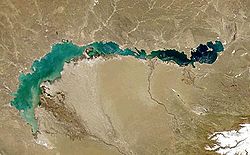
Balqash
Encyclopedia

Lake Balkhash
Lake Balkhash is one of the largest lakes in Asia and 12th largest continental lake in the world. It is located in southeastern Kazakhstan, in Central Asia, and belongs to an endorheic basin shared by Kazakhstan and China, with a small part in Kyrgyzstan. The basin drains into the lake via seven...
, Kazakhstan
Kazakhstan
Kazakhstan , officially the Republic of Kazakhstan, is a transcontinental country in Central Asia and Eastern Europe. Ranked as the ninth largest country in the world, it is also the world's largest landlocked country; its territory of is greater than Western Europe...
.
Balkhash was founded in 1937 as an industrial city centred around the mining and smelting of copper
Copper
Copper is a chemical element with the symbol Cu and atomic number 29. It is a ductile metal with very high thermal and electrical conductivity. Pure copper is soft and malleable; an exposed surface has a reddish-orange tarnish...
, and presently copper is still exploited there. The city lies approximately 500 km west of the Chinese border on the north side of the lake at an altitude of 440 m.
The history of the city is closely connected with mining of deposits of copper and development of a smelting plant.
History
In 1928, English capitalist Leslie Urquhart wrote to the Soviet government: "...will you allow me to search in the Kyrgyz steppe around Balkhash and further? You will not develop in these places sooner than 50 or 100 years, but I shall look for something, and maybe I will find it." Ten years later, in the Kounrad hills, near Lake Balkhash, Bolsheviks began mining copper ore.In the same year as Urquhart's proposal, a prospecting party from Leningrad headed by engineer-geologist Michael Rusakov arrived at the northern coast of Lake Balkhash and carried out the first investigation of deposits of copper. The results were encouraging, and prospecting work proceeded. The expedition came to the conclusion that the deposit had very rich stocks of ore, and based on this it would be possible to create a copper smelting plant. Michael Rusakov sent a telegram to the geological committee in Leningrad: "Discovered big copper-porphyritic deposit at Kounrad, near Lake Balkhash." Chairman Valerian Kuybyshev informed the delegates of the XVI congress VKP(b), and development of the deposit at Kounrad was soon begun. In October 1931, a management organization "Pribalkhash Stroi" was created, with as its main task the construction of a copper smelting plant. The coast of Bertis Bay was approved as the location of the basic industrial constructions and affiliated cities. The chief of building was Vasily Ivanovich Ivanov, who was later arrested in 1938 on false charges and executed as "the enemy of the Soviet people".
In 1932, the sum of 100 million ruble
Ruble
The ruble or rouble is a unit of currency. Currently, the currency units of Belarus, Russia, Abkhazia, South Ossetia and Transnistria, and, in the past, the currency units of several other countries, notably countries influenced by Russia and the Soviet Union, are named rubles, though they all are...
s was dedicated to construction of the copper giant, amounting to one-third of the total capital investments allocated for development of the heavy industry of the republic.
In March 1938, testing of the equipment of the concentrating factory began, and it produced the first concentrate. In July the first reverberatory furnace went into service — the foundation of metallurgical manufacture. On 24 November 1938, Balkhash's first copper was shipped out. Today a plaque has been placed at an entrance of the smelting plant commemorating this event, and 24 November is considered the birthday of the smelting plant. The ingot of Balkhash's first copper is kept in the Museum of the Revolution in Moscow.
The peaceful life of the inhabitants of Balkhash was broken with the attack of Nazi Germany
Nazi Germany
Nazi Germany , also known as the Third Reich , but officially called German Reich from 1933 to 1943 and Greater German Reich from 26 June 1943 onward, is the name commonly used to refer to the state of Germany from 1933 to 1945, when it was a totalitarian dictatorship ruled by...
on the Soviet Union
Soviet Union
The Soviet Union , officially the Union of Soviet Socialist Republics , was a constitutionally socialist state that existed in Eurasia between 1922 and 1991....
, and the workers were ordered to send more metal to the front. Many smelter workers and miners were sent away to the front, and their places in the industrial works and mines were filled with mothers, wives, and sisters. Before the war, 600 women worked in the factory, but in the first year of the war this number had already risen to 2453.
The population of the city gradually increased in 1960–1990 from 53 to 88 thousand people, but then rapidly declined to 65 thousand in 1999 and remained almost constant till 2010.

